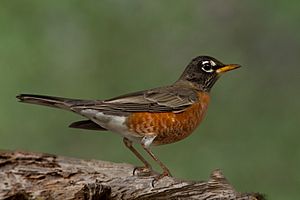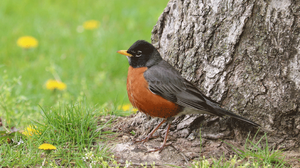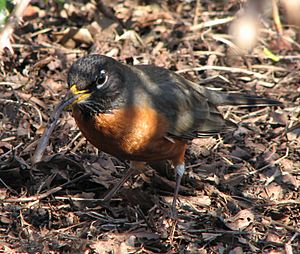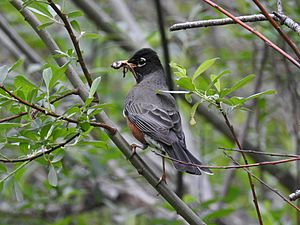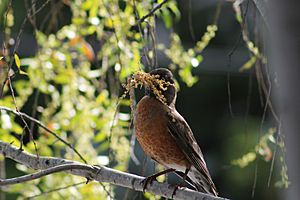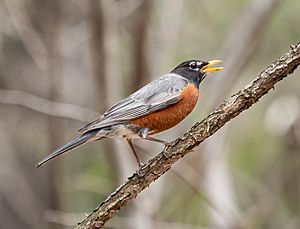American robin
Quick facts for kids American robin |
|
|---|---|
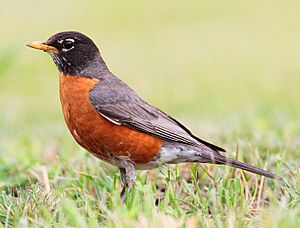 |
|
| Male | |
| Conservation status | |
| Scientific classification | |
| Genus: |
Turdus
|
| Species: |
migratorius
|
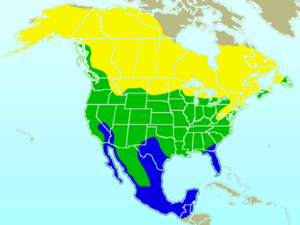 |
|
| Breeding range Year-round range Wintering range | |
| Synonyms | |
|
|
The American robin (Turdus migratorius) is a migratory bird that belongs to the thrush family. It got its name because its chest is reddish-orange, much like the European robin. However, these two birds are not closely related. The American robin lives all over North America. It spends its winters from southern Canada down to central Mexico and along the Pacific coast.
The American robin is the most common land bird in North America. There are about 370 million of them! This makes them more numerous than many other well-known birds. There are seven types, or subspecies, of American robins. One special type, the San Lucas robin, has pale gray-brown feathers on its belly.
Robins are usually active during the day. At night, they gather in large groups. They eat small creatures like grubs, earthworms, and caterpillars. They also enjoy fruits and berries. Robins are among the first birds to lay eggs each year. They start breeding soon after they return to their summer homes. Their nests are made of grass, twigs, and feathers, held together with mud. Robins are also known for singing early in the morning.
The main animal that hunts adult robins is the domestic cat. Hawks and snakes also hunt them. When robins are in groups, they watch each other for signs of danger. Sometimes, Brown-headed cowbirds try to lay their eggs in robin nests. But robins usually push these eggs out.
Contents
About the American Robin
The American robin was first described in 1766 by Carl Linnaeus. He gave it the scientific name Turdus migratorius. Turdus means "thrush" in Latin, and migratorius means "to migrate." The name "robin" has been used for this bird since at least 1703. The Turdus group includes about 65 types of thrushes. These birds often have round heads, long wings, and beautiful songs.
Scientists have studied the DNA of robins. This research helps us understand how different bird species are related. The American robin is related to some thrushes found in Central America. This suggests that robins might have spread north into North America more recently.
There are seven recognized types of American robins. They can look a bit different from each other.
- The eastern robin lives in the U.S. and Canada. It spends winters in warmer southern areas.
- The Newfoundland robin is darker. It breeds in parts of Canada and winters in the eastern U.S.
- The southern robin is smaller and has paler feathers. It lives in the southeastern U.S.
- The northwestern robin is slightly smaller and has a very dark head. It lives along the Pacific coast.
- The western robin is similar in size to the eastern robin but looks paler. It lives in western North America.
- The San Lucas robin is quite unique. It has pale gray-brown feathers on its belly. It lives in the highlands of southern Baja California.
- The Mexican robin lives in Mexico. It is a bit smaller than the western robin but has a larger beak.
What Does an American Robin Look Like?
The eastern American robin is about 23 to 28 centimeters (9 to 11 inches) long. Its wings can spread from 31 to 41 centimeters (12 to 16 inches). On average, a robin weighs about 77 grams (2.7 ounces). Males are usually a bit heavier than females.
Robins have a head that can be black or gray. They have white rings around their eyes. Their throat is white with black stripes. Their belly and the feathers under their tail are white. The back of a robin is brown, and its chest is a reddish-orange color. Their beak is mostly yellow with a dark tip. Their legs and feet are brown.
Male and female robins look similar. However, females often have duller colors than males. Young robins, called juveniles, are paler than adults. They have dark spots on their chests. It can be hard to tell young adults from older ones, but young birds might have some duller feathers.
Where Do American Robins Live?
American robins breed across most of North America. This includes Alaska, Canada, and down to northern Florida and Mexico. While some robins stay in northern areas during winter, most fly south. They go to places like Florida, the Gulf Coast, and central Mexico. Most robins leave for the south by late August. They start returning north in February and March. The exact dates depend on the weather and location. Robins from Alaska might travel much farther than robins from Massachusetts.
Sometimes, robins fly far off course. They have been seen in western Europe, especially Great Britain. In 2003, several American robins were seen in Great Britain. They also sometimes visit places like Greenland, Jamaica, and Puerto Rico.
Robins like to breed in woodlands, open farmlands, and even cities. They are less common in the southernmost parts of the U.S. there they prefer large shade trees in yards. In winter, they live in similar places but also in more open areas.
Health and the West Nile Virus
The American robin can carry the West Nile virus. This virus is spread by mosquitoes. While other birds like crows often die quickly from the virus, robins can survive longer. This means they can spread the virus to more mosquitoes, which then can pass it to humans.
Scientists have given a vaccine to young robins. This vaccine greatly reduced the amount of virus in their bodies. This would likely stop them from spreading the disease. Researchers are looking for ways to give the vaccine to robins through food, which would be easier than injections.
American Robin Behavior
Robins are mostly active during the day. In winter, they gather in large groups at night. They roost in trees in quiet swamps or thick bushes. During the day, these groups break up. The birds then feed on fruits and berries in smaller groups. In summer, robins protect their breeding areas and are less social.
What Do American Robins Eat?

The American robin's diet is usually about 40 percent small creatures. These include earthworms, beetle grubs, caterpillars, and grasshoppers. The other 60 percent of their diet is wild and farmed fruits and berries. Because they can eat berries, they can spend winters much farther north than many other thrushes.
Robins mostly look for food on the ground. They find worms by seeing them, and sometimes by hearing them. They pounce on the worms and pull them out of the ground. Baby robins are fed mostly earthworms and other soft animals. In some areas, robins even feed on beaches, eating insects and small snails. Robins can be a problem for fruit farms in North America.
Robins use their sight, hearing, and smell to find food. Vision is the most important way they find prey. You often see them running across lawns, stopping to pick up earthworms. This "running and stopping" is a clear sign of a robin. They also listen for worms underground. They take a few short hops, then tilt their head to listen for movement. In cities, robins often gather where lawns have just been mowed or where sprinklers are on.
Who Hunts American Robins?
Young robins and eggs are hunted by squirrels, snakes, and some birds. These birds include blue jays, American crows, and common ravens. Adult robins are mainly hunted by hawks, cats, and larger snakes. Mammals like foxes and dogs might catch young robins on the ground. Raccoons often raid nests. Small animals like American martens can hunt adult robins.
However, the biggest threat to adult robins comes from birds of prey. These include many types of hawks and owls. In total, 28 different kinds of birds of prey are known to hunt American robins. Adult robins are most at risk when they are busy breeding. But when robins are in groups, they watch each other for danger.
Robins are known to reject cowbird eggs. This means that cowbirds rarely succeed in laying their eggs in robin nests. Even if a cowbird egg is laid, the baby cowbird usually does not survive.
Reproduction and Life Cycle
The American robin starts breeding soon after it returns to its summer home. It is one of the first North American birds to lay eggs. A robin usually has two to three groups of babies each breeding season. This season lasts from April to July.
The female robin builds the nest by herself. Nests are usually 1.5 to 4.5 meters (5 to 15 feet) off the ground. They are built in a thick bush or between tree branches. The outside of the nest is made of long grass, twigs, and feathers. This is then lined with mud and cushioned with fine grass. Robins build a new nest for each group of babies. In northern areas, the first nest is often in an evergreen tree. Later nests are in deciduous trees. Robins are not afraid to build nests close to people's homes.
A robin's nest usually has three to five blue-green eggs. Only the female sits on the eggs to keep them warm. The eggs hatch after about 14 days. The baby birds, called chicks, leave the nest about two weeks later. When they first hatch, the chicks are naked and their eyes are closed.
The chicks are fed earthworms, insects, and berries. The parents keep the nest clean by taking away the chicks' waste. All the chicks in a nest leave within two days of each other. Young robins can fly well about two weeks after leaving the nest. They can have their own babies when they are one year old. Only about 25% of young robins survive their first year. The oldest known wild robin lived for 14 years. The average robin lives for about two years.
Robin Songs and Calls
Male American robins have a complex and almost constant song. It sounds like a "cheery" carol. The song is made of different sounds that are often repeated. Robins sing from late February or early March to late July or early August. Some birds sing even later. They are often among the first birds to sing at dawn. They also sing as evening sets in. Robins usually sing from a high spot in a tree.
Robins also sing when storms are coming and after they have passed. Besides their song, they have different calls. These calls share specific information. For example, they have a call for when a predator is near the ground. They also have a call for when a nest or another robin is in danger. Even when they are protecting their territory, robins might team up to scare away a predator.
Protecting American Robins
The American robin lives in a very large area. This area is estimated to be about 16 million square kilometers (6.2 million square miles). There are about 370 million robins. The number of robins seems to be stable. Because of their large numbers and wide range, they are considered a species of "Least Concern" by conservation groups. This means they are not currently at risk of disappearing.
In the past, robins were hunted for their meat. But now, they are protected in the United States by the Migratory Bird Treaty Act of 1918.
Robins in Culture
The color "Robin egg blue" is named after the bright blue color of the bird's eggs.
The American robin is the official state bird of Connecticut, Michigan, and Wisconsin. It was also shown on a Canadian $2 banknote in 1986.
Robins are important in Native American stories. One story tells how the robin got its red chest. It fanned a dying campfire to save a man and a boy. This story is similar to tales about the European robin. The Tlingit people believed the robin was created by Raven to make people happy with its song.
The American robin is seen as a symbol of spring. Many poems have been written about the first robin of spring. People often believe that seeing the first robin of spring brings good luck. Robins tend to follow the 37°F (3°C) temperature line. They fly north in spring when it gets warmer and south in fall when it gets colder.
Popular songs also feature the robin. One famous song is "When the Red, Red Robin (Comes Bob, Bob, Bobbin' Along)". The comic book superhero Robin was named after the bird.
Images for kids
See also
 In Spanish: Zorzal robín para niños
In Spanish: Zorzal robín para niños



